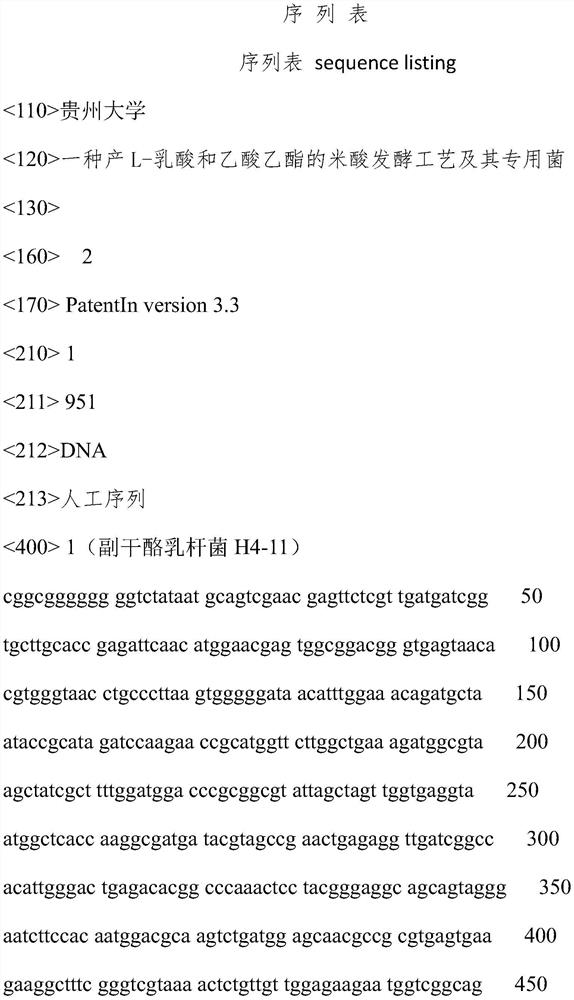A rice acid fermentation process for producing L-lactic acid and ethyl acetate and its special bacteria
A technology of ethyl acetate and fermentation process, which is applied to Lactobacillus, bacteria and bacteria used in food preparation, can solve the problems of long production cycle of rice acid and unstable product quality, and achieves good taste and flavor, strong performance, The effect of good antioxidant properties
- Summary
- Abstract
- Description
- Claims
- Application Information
AI Technical Summary
Problems solved by technology
Method used
Image
Examples
Embodiment 1
[0034] A rice acid fermentation process producing L-lactic acid and ethyl acetate, comprising the following processes:
[0035] (1) raw material pretreatment: high-speed pulverization of selenium rice, mixing, passing through an 80-mesh sieve twice to make rice flour; (2) boiling: mixing rice flour and water, the content of rice flour after mixing is 8%, heating and boiling, while Stir while heating;
[0036] (3) Gelatinization: put the boiled rice soup into a water bath for gelatinization, and stir while gelatinizing; to prevent local deterioration of the gelatinization liquid caused by uneven gelatinization; the gelatinization time is 30 minutes, and the gelatinization temperature is 60°C;
[0037] (4) Liquefaction: Add 1.0% of its quality high-temperature α-amylase to the gelatinized rice soup for liquefaction, the liquefaction time is 30min, and the liquefaction temperature is 95°C;
[0038] (5) deployment and sterilization: add honey with a mass of 5.0% to the liquefied ...
Embodiment 2
[0042] A rice acid fermentation process producing L-lactic acid and ethyl acetate, comprising the following processes:
[0043] (1) raw material pretreatment: crush selenium rice at high speed, mix, and pass through an 80-mesh sieve twice to make rice flour;
[0044] (2) Boil: mix rice flour and water, the content of rice flour after mixing is 8%, heat to boil, stir while heating;
[0045] (3) Gelatinization: put the boiled rice soup into a water bath for gelatinization, and stir while gelatinizing; to prevent local deterioration of the gelatinization liquid caused by uneven gelatinization; the gelatinization time is 30 minutes, and the gelatinization temperature is 60°C;
[0046] (4) Liquefaction: Add 1.0% of its quality high-temperature α-amylase to the gelatinized rice soup for liquefaction, the liquefaction time is 30min, and the liquefaction temperature is 95°C;
[0047] (5) Saccharification: add 0.02% of its mass glucoamylase to the liquefied rice soup, the saccharifica...
Embodiment 3
[0052] The difference between embodiment 3 and embodiment 2 is that what is added in the step (6) is not honey but the extract of G.
PUM
| Property | Measurement | Unit |
|---|---|---|
| clearance rate | aaaaa | aaaaa |
Abstract
Description
Claims
Application Information
 Login to View More
Login to View More - R&D
- Intellectual Property
- Life Sciences
- Materials
- Tech Scout
- Unparalleled Data Quality
- Higher Quality Content
- 60% Fewer Hallucinations
Browse by: Latest US Patents, China's latest patents, Technical Efficacy Thesaurus, Application Domain, Technology Topic, Popular Technical Reports.
© 2025 PatSnap. All rights reserved.Legal|Privacy policy|Modern Slavery Act Transparency Statement|Sitemap|About US| Contact US: help@patsnap.com



